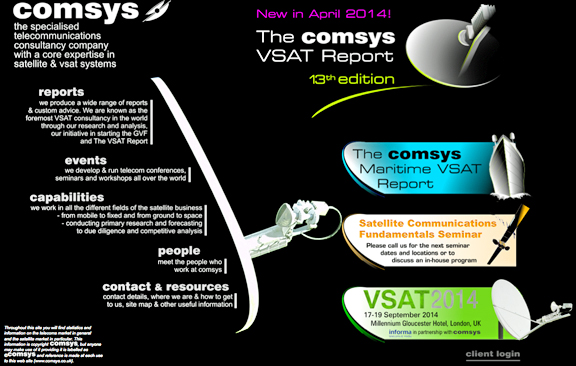
[SatNews] The 13th edition of the COMSYS VSAT Report is now available and, for the first time, is also available as a PDF—the VSAT Report is the result of more than 12 months of research, involving site visits and interviews with companies from Australia to Argentina and from Pakistan to Peru.
This comprehensive report includes:
- More than 1,500 pages in three volumes
- Detailed information on all Star TDMA and SCPC as well as Mesh and Star DAMA systems
- Three-year forecast data for sites in service and revenues, presented by region and industry sector
- Predictions for the future of VSAT technologies, new opportunities and markets
- Business planning analysis for potential system users
- Extensive company marketing, sales and strategic information
- Assessment of the current state, capabilities and challenges of the industry and market
- Detailed analysis of multi-beam Ka-band satellite systems and their potential effects on the market
- Volume I (591 pages with over 400 tables and charts) analyses enterprise, SME and consumer sales of VSAT systems by vendor, operator, geography, industry and revenues
- Volume II (342 pages) covers technical specifications, prices, shipments, customer references and company analysis for over thirty VSAT systems from 19 different vendors
- Volume III (623 pages) contains detailed analysis of more than 160 VSAT service operations from around the world
The VSAT Report is an invaluable reference source on this industry, enabling telecommunication and IT managers, existing and prospective system operators, manufacturers and integrators to stay competitive and increase profitability. It remains the definitive study of direct-to-business earth station products and services. More detailed information on the report and some of its findings can be found at http://www.comsys.co.uk/ where additional information may be found.
The report’s primary findings are as follows:
- Operator VSAT service revenues grew by 3.9 per cent between 2011 and 2012 from $4.57 billion to $4.75 billion with the primary engines of growth being Europe, Asia / Pacific and North America
- Stronger sales in the enterprise business were primarily the result of large deployments for government and financial applications as the need to extend connectivity and government services gained ground in many countries and several large programmes were initiated or extended. On a smaller scale, sales through carriers for network extension and business continuity (coupled with specialist services for maritime, cellular backhaul and utilities) also grew robustly
- The market for “classical” VSAT terminals (star data configuration) grew in sales volume in 2012 to around 360,000 units. Hub sales grew by five per cent to over 490 in 2012 as operators continued to establish local operations in markets opened up by international fibre capacity and to invest more rapidly to take advantage of short term opportunities. Enterprise hardware revenues rose by 7 per cent to $815 million and operator service revenues grew 6.5 per cent to over $3.05 billion, up from $2.87 billion in 2011
- Highlights include new networks and extensions for banking ATMs, government projects, lotteries and utilities as well as hybrid business continuity and carrier extension in the enterprise segment. Corporate services saw demand for new sites and higher data rates for offshore oil & gas, land-based drilling, disaster and emergency applications, mining, GSM backhaul, maritime and aeronautical services
- Average bandwidth demands are growing - in some cases doubling annually - as users expect reliable high bandwidth connections regardless of location. Video and social networking applications are stimulating the need for much higher data rates in VSAT networks, even for secondary connections
- Government “rural digital inclusion” projects rely heavily on VSAT technology and remain a source of major business as solving “the digital divide” continues to rate highly on the political agenda
- The Military - particularly the US DoD - remains reliant on VSAT technology but budget cuts and sequestration in the US, coupled with service renewals, have changed the service landscape. The withdrawal from Afghanistan by the end of 2014 is expected to cause further upheaval and difficulties for some operators. However, the level of military demand in other countries, especially in Asia, has been maintained
- Lotteries continue to favor VSAT as cost-effectiveness has grown (when compared to terrestrial solutions), but sales have been largely confined over the past two years to the expansion of existing networks rather than new contracts
- TDMA terminal prices continued to fall, but not as dramatically as has been witnessed in previous years. However, commitments for consumer satellite projects raise the possibility that prices could reduce dramatically in the future
The report also addresses Ka-band, spot-beam, high-bandwidth spacecraft which are expected to increase global FSS capacity by an order of magnitude to almost 1.8 Tbits / second by 2016.
- As of mid-2013 consumer satellite Internet services served over 1.65 million subscribers worldwide, the majority of which are in the United States
- 2014 will see O3b Networks initiate commercial service and potentially stimulate demand in some markets for local VSAT hub services. Inmarsat’s $1.6 billion Global Xpress Ka-band mobility satellite constellation will also begin commercial operations, promising to extend the addressable market for maritime VSAT services
- Intelsat’s innovative EpicNG initiative, Hughes’ Jupiter-2 and ViaSat’s ViaSat-2 satellites point towards the future development of the satellite industry
- The Ka-band spot-beam satellite systems now in service have already begun to substantially change the competitive environment in several regions of the world and are changing conventional bandwidth supply and demand economics

